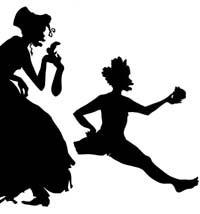Jim Crow Museum
1010 Campus Drive
Big Rapids, MI 49307
[email protected]
(231) 591-5873
I find Kara Walker's art offensive. Her work belongs in your museum because it is as racist as the stuff you display.
-- Anne Townsend - Sturgis, Michigan

When she was only 24, Kara Walker made a name for herself as a provocative youngster who addressed highly charged racial, social, and personal issues with wit, rage, irony — and art — in a group show of new talent at The Drawing Center, in Manhattan. Titled Gone: An Historical Romance of Civil War As It Occurred Between the Dusky Thighs of One Young Negress and Her Heart, Walker's sole, monumental work depicted antebellum Southern life in life-size silhouettes cut from black paper and affixed to white walls. At first glance the cutouts had a polite, front parlor veneer left over from the art form's popularity as a Victorian portrait technique. But on closer inspection, this fairy-tale world was worthy of the Brothers Grimm. In it, men, women, and children, both black and white, engaged in various indecorous activities, including forbidden, fetishized sex play, and women in long dresses concealed all manner of mysterious things under their skirts. The show caused a furor. Older, well-known African-American artists like Bettye Saar attacked Walker for portraying racial stereotypes rather than aggressively attacking them; some called for a boycott.
Walker, (who became) an associate professor in the (Columbia) School of the Arts, held her ground. Born in California and educated at the Atlanta College of Art and the Rhode Island School of Design, she once said that she decided early on that if she was going to make work that dealt with race issues, "it was going to be full of contradictions . . . . When I was coming along in Georgia, I became black in more senses than just the kind of multicultural acceptance that I grew up with in California. Blackness became a very loaded subject, a very loaded thing to be — all about forbidden passions and desires, and all about a history that's still living, very present."
The silhouette technique, which she still employs, reflects many of her concerns — it is, as many have pointed out, black; it is elemental, a tool of cartooning, as well as a form of child's play. Her images, while shocking in a thoroughly contemporary way, also evoke the magical and disturbing renderings of early book illustrators like Arthur Rackham. In some installations, Walker also slyly incorporates unwitting viewers, whose shadows, cast as they stroll in front of lights, interact with the "shadows" of the cut paper figures on the walls. Historical overtones abound in all of Walker's works: In the cutouts, her imagery is reminiscent of early Dutch genre painters. In sepia wash drawings, Walker conjures the eighteenth-century caricatures of Thomas Rowlandson. There are echoes of the Rococo, of Fragonard in her brushwork.

For some exhibitions, Walker also includes index cards, on which she types ideas, provoking the viewer to connect, reconfigure, and interpret the images on the walls. Early on, she says, she began keeping a notebook of "just about anything that I could, to process what blackness was and is all about for me — very personal writings, along with just clippings, nothing that was art, just a way of getting at ideas."
Such voracious reflection infuses her teaching as well as her art. At Columbia, where she has taught undergraduate and graduate classes, student Marc Handelman ('03SOA) recalls "her effort to really see what I was making and spend time thinking about it before heading straight into a discussion. There was a lot of questioning — enough to make me reconsider my strongly felt convictions about my work." Handelman (went on to become) Walker's studio assistant.
. . . Since her first, explosive exhibition, Walker has continued to make works that employ taboo goings-on and obsessive sexual content, and these continue to astonish critics and viewers. But she has also been a MacArthur Foundation grantee, the United States representative to the 2002 Sao Paulo Biennial — and an associate professor. Although few would dare to call Walker an Establishment artist, she is now, arguably, established.
September 2008 response courtesy of Columbia Magazine. The silhouettes on this page are from a permanent installation at Columbia University's Dodge Hall created by Kara Walker for the School of the Arts. The work is titled The Policy of Admission.